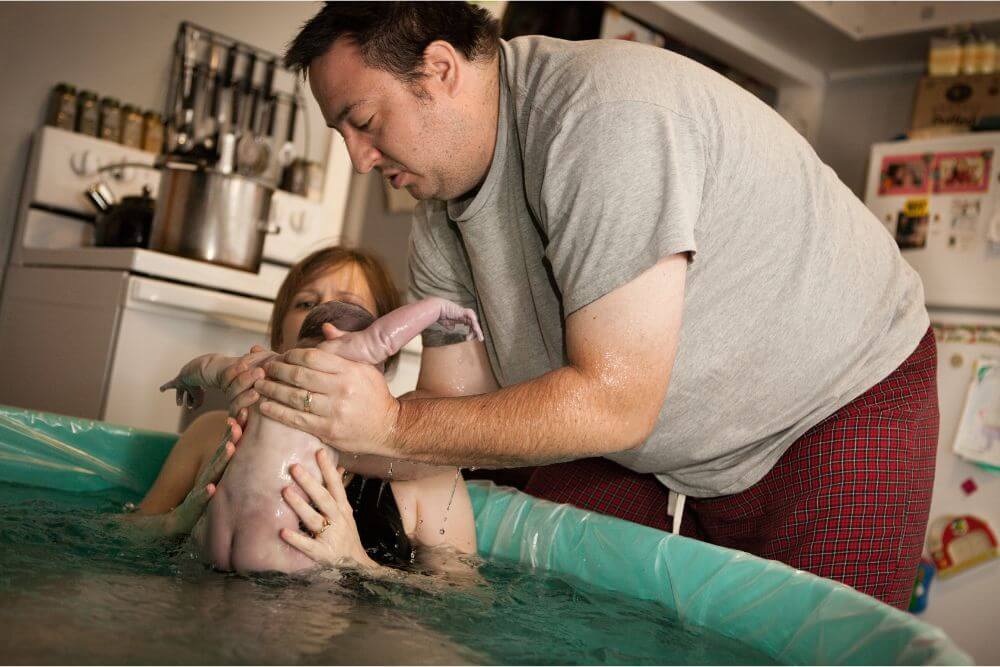Long gone are the days when fathers-to-be are left waiting in the wings to hear the announcement of their child’s birth by the attendant midwife or doctor.
Instead, more partners than ever are playing an active role in the birth of their child. Birth partners are often (but not always) quite keen to learn all they can, in order to help during labour.
Supporting a woman when she’s giving birth is a big responsibility and an honour. It can be hugely rewarding for the support person but also exhausting, particularly if the labour lasts for many hours throughout the night, or even for days on end.
A birth partner isn’t always the father of the baby. They might be:
- a same-sex partner and co-parent
- the woman’s parent
- a close friend
- a sibling or other relative
- a paid professional, such as a doula
The birthing woman is going to be looking to you as her birth partner for comfort, strength, and encouragement during the entire labour and birth process. And although you may find it hard to watch her in pain, you’ll likely discover that childbirth can be one of life’s most powerful and rewarding moments.
As a midwife, I have seen a whole range of behaviours from birth partners, whilst quietly observing and waiting for baby’s arrival.
These range from resembling the proverbial ‘headless chicken’ and blind panic to disassociation, scrolling on phones and talking about how tired THEY are feeling! ….. to quiet, calm, closeness, encouragement stroking and advocating.
Sometimes these behaviours can be quite irritating to the labouring woman and can create conflict and tension at a time when her body needs emotional calm & confidence to allow the birth process to unfold. Doing some preparation for your role as her birth partner will pay huge dividends and will be less stressful for you too.

Establish some common ground as a birth partner
Getting ready for a new baby takes time and you may find that your time & focus is around more practical tasks such as creating a nursery, putting the cot together and fitting the car seat.
All of this whilst you are both working, and managing a massive pile of life laundry.
Learning how best to support your partner during labour and birth may become a lower priority on your task list and you may have concluded that the attendant staff will know what they are doing, so you will be guided by them. However it’s a good idea to sit down and discuss some birth preferences to find out what your partner would like and to write these down so that when she is in the throes of labour and cannot easily verbalise what she needs, that you will step in as her advocate as let’s face it you know her better than anyone else !!
If you’re feeling particularly nervous or unsure about being the main support person for your partner, it’s important to discuss this with her. It’s perfectly normal to feel this way, so don’t feel bad if you feel that you aren’t comfortable. It’s more important for you to talk about your feelings and ideally find someone else who can support you both during this time. Many hospital trusts have now reintroduced a second birth partner policy again so check this out if you are unsure.
Ideas to help prepare as a birth partner
Below are some ideas to help you prepare for your role as a birth partner. I’ve broken them down by stages of labour to help you understand how you can support at each and every stage.
How to help before the Birth
- Every birth can be different and things don’t always go according to plan, so be prepared to be flexible.
- Do your Complete Hypnobirthing and Newborn Course together.
- Discuss her birth preferences, including what to do if things don’t go to plan and draw up a list to take into hospital or to give to your home birth team.
- Listen to some Hypnobirthing audio and affirmations together.
- See if you can do a tour of the birth centre or delivery suite, or if the hospital have a virtual tour that you can watch online.
- Work out the best route to the hospital where to park when you arrive in labour and where the delivery suite and birth centre are.
- Help her with perineal massage from 34 weeks and colostrum harvesting from 37 weeks if this is something she is keen to do.
- If you are having a pool birth at home, do a practise run and fill the pool (minus the liner) before 37 weeks to make sure all of the connectors fit the taps and to see how long the filling and emptying take before the big day arrives.
Things to do as a birth partner during early (latent) labour
Unlike in a TV drama where labour starts dramatically and progresses rapidly, women are likely to spend hours or sometimes days in early labour whilst the uterine surges are organising themselves and becoming more regular and coordinated, and research has shown that the best place to be during this stage of labour is at home in privacy, without feeling observed.
Ring your care provider if you wish to get some reassurance, and she will discuss ways to manage the latent stage such as getting outside for a walk, soaking in the bath, applying the TENS machine to her back, massage, playing affirmations, preparing a delicious snack and offering frequent drinks, watching a favourite film and alternately spending time on a birth ball then getting some sleep as this phase can be exhausting.
Your care provider will help you to decide when to go to the hospital or when she needs to make her way over to your home if you are having a home birth.
One big piece of advice is not to broadcast to friends and family that you think labour might have started as the relentless messages that follow can become frustrating when you have no more news to share at that point.

What to do during advanced labour
Sometimes referred to as the “Foot on the gas” phase of labour when the contraction surges become more frequent, longer and stronger and require her full & complete concentration. Contractions are much more intense, last about 40 to 60 seconds, and are spaced three to five minutes apart. You will need to be intuitive and try and understand what she needs and when. Especially if she is in too much discomfort to express it well herself.
Be aware that her needs might change as her labour progresses. At times during labour, she might appreciate your emotional and physical support. Yet there might be other times when she would like to be left alone to help her to focus inwards. If you are upbeat and confident in your partner’s ability to give birth, this will help encourage and support her. Words are powerful. You can help your partner stay motivated during labour by offering words of encouragement. Tell her how much you love her, how well she is doing. Also, respect her wishes if she asks you to be quiet. Encourage her to use any relaxation and breathing techniques you have learnt, perhaps by doing them with her.
Remember, it’s not a good idea to chat during a contraction surge when she will be drawing on all of her strength to manage the sensations. Gentle touch or massage might be welcome, but again it might also be irritating, so just use your instinct and judgement and don’t take it personally if she is snappy.
Helping during Transition as a supportive birth partner
In labour, somewhere between the cervix stretching fully open & the urge to push kicking in, there is a huge (and completely normal) surge in adrenalin as the muscles that have been stretching the cervix widely open now start to squeeze the baby down.
This phase can last anywhere from a few minutes to several hours. It’s here that things are likely to start getting a little , or a lot, more intense. Contractions last 60 seconds or more and come almost 2 minutes apart. There is a noticeable change in your partner’s behaviour, and she may hit panic mode. Phrases such as “I can’t do any more”, “I want a caesarean”, “I need an epidural”, are commonly heard and she may also become more vocal and restless and start making primal, guttural noises (a lot like a cow mooing !)
As a birth partner, if you’re not anticipating this short phase that happens just before she starts to push, it can feel quite scary! So, knowing what it is makes it much easier to remain calm and be the steady reassurance your partner needs during this potentially wobbly stage of labour. Encourage her to relax and ‘let go’ in between the very frequent contraction surges will help , encourage her to loosen her jaw, her shoulders, close her eyes have a sip of water and get ready for the next surge.
This is potentially the most distressing phase for you too, as you feel helpless seeing your loved one like this, but keep reminding her that this is a sign that she is getting very close to meeting baby, that you love her, you are proud of her, that she is strong and oh so powerful.

Your moment to support during Birth
She might not be able to see what is happening as the baby is being born. So help to motivate her by telling her what is happening and when you can see the baby’s head. If she births in the pool, encourage her to lift baby to the surface or do this yourself if she feels overwhelmed.
What you can do during the Birth of the Placenta and aftercare
It’s not over yet! This stage begins immediately after baby is born and ends with the birth of the placenta 10-60 mins later typically. Your partner may get a case of the postpartum chills or feel very shaky during this stage. If that’s the case, be ready to offer a warm blanket and to hold your newborn while your partner regains her strength. Once the placenta has been birthed, the midwife will check your partner to see if she needs any repair to the perineum. This can be uncomfortable, and she may require some gas and air during the examination, so it might help if you take baby for some skin to skin until the procedure is completed.
Remember to care for yourself
Being a birth partner can be exhausting, so look after yourself as well as her, including taking rest breaks when it works for your partner or if there is another support person there.
Bring snacks and drinks for yourself, comfortable footwear, a clean t-shirt and toothbrush, and swimwear if you plan to join her in the birthing pool, and mobile phone chargers so you can get those all important birth photos!
Top 10 tips for being a fabulous birth partner
- Trust your partner. Above all else. Trust her concerns, trust her body, trust her decisions – she has baby’s best interests at heart always!
- Educate yourself on how birth works, and understand your choices and options. Work through your antenatal education with her (The Complete Hypnobirthing and Newborn Course is an ideal place to start and can be watched from anywhere in the world). Alternatively the book Men, Love & Birth by Mark Harris is a good recommended read.
- Draw up some birth preferences with your partner, and know what’s on the list and why it is important.
- Protect her emotional wellbeing in pregnancy, and your own!!, if someone is passing judgement or scaring either of you about their own birth experience, ask them to stop.
- Advocate for your partner in pregnancy, labour and birth. As a birth partner, you can be her voice when she might be struggling to communicate.
- Be the gatekeeper to her birth space/ the keeper of the cave. Who’s coming in and out and why? You can ask them to remain outside or leave the room and gather themselves together before returning to keep to keep the birth space calm
- Don’t disturb her in labour, lots of questions and conversation brings her out of her mammalian brain, stimulate her neocortex and stop her from behaving instinctively- an absolute requirement for labour and birth!
- Have some comforting tools up your sleeve, although you may not need any of them! Massage techniques, affirmations, kind words, encouragement to eat, drink, go for a wee IF she needs it …. if she’s getting on just fine then …
- Hold back! Honestly, the hardest part of being a birth partner is doing nothing. But often that’s exactly what is needed. At home feel free to potter, makes snack, rest, be ‘around’ and present, but avoiding staring, putting any pressure on, noticeably timing contractions or fussing too much! Your quiet, calm, confident presence may be all that is needed.
- Remember, you’re an expert when it comes to your partner. No one will understand your partner the way you do, tune into your partner’s needs, concerns and strengths in a way that nobody else can! With you she can be uninhibited, feel safe and fully relax – you are the perfect support for her in labour!
To prepare for your role as a birth partner – why not sign up for the Complete Hypnobirthing and Newborn Course – preparation you can do together, at a time that suits you, with a midwife on hand to ask any questions.











0 Comments